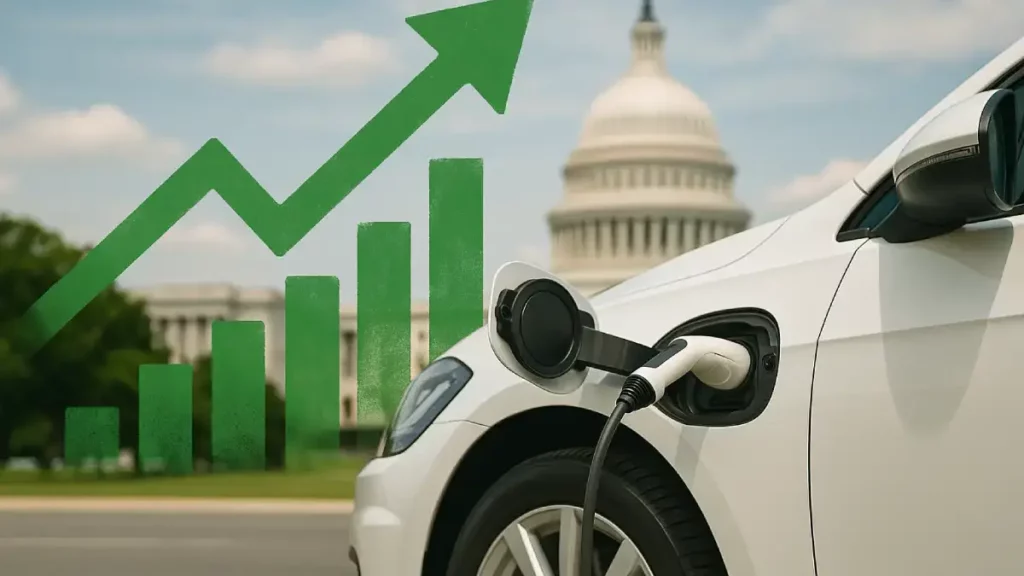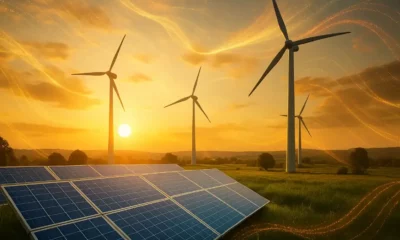How Government Policies Impact Electric Vehicle Adoption: A Comprehensive Analysis
How Government Policies Impact Electric Vehicle Adoption: A Comprehensive Analysis
Estimated reading time: 10 minutes
Key Takeaways
- Government policies (financial incentives, regulations, infrastructure support) are primary drivers of electric vehicle (EV) adoption rates globally.
- Financial incentives like tax credits and rebates directly lower the upfront cost of EVs, making them accessible to more consumers.
- Regulations such as ZEV mandates and emissions standards push automakers to produce and sell more EVs, transforming the industry.
- Government investment in charging infrastructure is crucial for addressing range anxiety and supporting a growing EV market.
- Policy consistency, equity considerations, and international coordination are key challenges that need addressing for sustained EV growth.
- Future policies should focus on targeted incentives for equitable access, expanding charging in underserved areas, and integrating EVs with clean energy grids.

Table of Contents
- Introduction: Why Government Policies Matter for EVs
- The Fundamental Role of Government Policies in EV Adoption
- Financial Incentives Transforming the EV Landscape
- Regulatory Frameworks Driving Industry Transformation
- Government Infrastructure Initiatives Supporting EV Ecosystem
- Critical Analysis: Market Impact of Government Policies
- Challenges and Limitations of Current Policy Approaches
- Future Policy Directions for Sustained EV Growth
- Conclusion: The Undeniable Impact
- FAQ
Introduction: Why Government Policies Matter for EVs
Electric cars, often called EVs, are becoming more popular every day. You might see more of them on the roads in your town. Have you ever wondered why? A big reason is the rules and help offered by governments. Understanding how government policies impact electric vehicle adoption is super important.
Recent numbers show that more and more people are choosing electric cars. This big change doesn’t just happen on its own. Government policies play a huge part in guiding the EV market. They act like a helping hand, encouraging people and car companies to choose electric.
“The transition to electric mobility isn’t just about technology; it’s significantly shaped by the policies governments put in place.”
This blog post will explore exactly how different government initiatives, regulations, and incentives are speeding up the switch to electric vehicles. We will look at the different ways governments around the world are pushing for cleaner cars.
Knowing about these government policies is helpful for everyone. If you’re thinking about buying an EV, these rules can save you money. If you work in the car industry, these policies shape your company’s future. And for the people making the rules (policymakers), understanding what works best helps them make better plans for our planet.
Here’s what we will cover:
- The basic ways government rules help EV adoption.
- How money-saving offers (incentives) make EVs cheaper.
- How rules (regulations) push car companies to make more EVs.
- How government projects build more charging stations.
- A closer look at how these rules change the whole EV market.
- Some problems or challenges with the current rules.
- What future rules might look like to keep EV growth strong.
Let’s dive in and see how governments are putting the world on the road to electric driving.
The Fundamental Role of Government Policies in EV Adoption
Why do government policies matter so much for EV adoption? Think of it like building with blocks. Government rules and support are like the base blocks that help build a tall tower of electric cars. Without that strong base, it’s much harder for EVs to become common.
Government policies work in two main ways to increase EV adoption:
- Push Factors: These are rules that push car makers away from gasoline cars. They might include limits on pollution or requirements to sell clean cars.
- Pull Factors: These are offers that pull buyers towards electric cars. Think of discounts or special perks that make buying an EV more attractive.
These policies fall into two big groups:
- Financial Incentives: This is help with money. It includes things like direct discounts (subsidies), money back on your taxes (tax breaks), or special grants. These make EVs less expensive to buy and own.
- Regulatory Measures: These are the official rules. Examples include regulations setting limits on car pollution (emissions) or rules demanding cars get better gas mileage (fuel efficiency standards). Some rules even set dates by which only electric cars can be sold.
Studies show a clear link: places with strong government policies supporting EVs usually have much higher EV adoption rates. People are more likely to buy an electric car if the government makes it easier and cheaper.
A great example is the United States. The federal government offers help through tax breaks. Under a law called the Inflation Reduction Act, if you buy an electric car that qualifies, you might get up to $7,500 back on your taxes. This makes a big difference in the final price. For further information on related incentives, you can read more about solar energy tax credits.
“Norway’s success, with nearly 80% of new car sales being electric, is a testament to the power of aggressive and comprehensive government support for EVs.”
Now, let’s look at Norway. This country is a world leader in EV adoption. How did they do it? Through very strong government policies. Norway used lots of incentives like removing purchase taxes and offering free parking and toll roads for EVs. Because of these aggressive policies, almost 8 out of every 10 new cars sold in Norway are electric! This shows how powerful government action can be.
Financial Incentives Transforming the EV Landscape
One of the biggest hurdles for electric cars has been their price tag. They often cost more to buy upfront than gasoline cars. This is where financial incentives come in – they are super important government initiatives designed to make EVs more affordable for everyone. Let’s break down the main types of financial help.
Types of Financial Incentives:
- Direct Purchase Incentives: This is like getting an instant discount when you buy the car. Sometimes it’s called a point-of-sale rebate. You pay less right at the dealership. This is often the most straightforward way to lower the cost.
- Tax Breaks: These save you money on your taxes.
- Income Tax Credits: Like the U.S. federal credit, this reduces the amount of income tax you owe at the end of the year. You get the money back later, but it still lowers the overall cost. Some places offer tax breaks for installing a home charger too.
- VAT Exemptions: In some countries, Value Added Tax (VAT) – a type of sales tax – is removed or reduced for EVs. This can mean a significant price cut.
- Reduced Ownership Costs: Governments can also make owning an EV cheaper day-to-day.
- Lower Registration Fees: Paying less each year to register your electric car saves money over time.
- Toll Exemptions: Some cities or regions let EV drivers use toll roads for free or at a lower cost.
- Parking Perks: Free or cheaper parking spots reserved for EVs can also add up.
Examples from Around the World:
- United States: The federal government offers income tax breaks up to $7,500 for new EVs and up to $4,000 for used EVs, thanks to the Inflation Reduction Act. The rules depend on where the car and its battery parts were made, and the buyer’s income. Many states also offer their own rebates or tax credits on top of the federal one.
- Europe: Many European countries have strong purchase incentives. Germany, France, and Italy have offered generous subsidies, sometimes worth thousands of euros, directly reducing the price at the time of purchase. These programs change over time but have been key drivers of EV sales.
- China: China used a powerful subsidy approach for many years. They initially offered large discounts to buyers. Over time, as the EV market grew and costs came down, they gradually reduced the subsidies. This phased strategy helped China become the world’s biggest market for electric cars.
“Financial incentives directly tackle the biggest barrier for many potential EV buyers: the initial purchase price.”
Why Financial Incentives Matter:
These financial support mechanisms directly tackle the price difference between electric cars and traditional gasoline cars. By bringing the cost down, government initiatives make EVs a realistic choice for more families and individuals.
China’s approach is a great case study. By starting with large subsidies and then slowly reducing them as the market matured, they encouraged both buying and manufacturing EVs within China. This careful planning helped build their massive domestic EV market. (Source)
Data clearly shows that when governments offer strong purchase incentives, EV sales go up. In markets where incentives were reduced or removed too quickly, sales often slowed down. This highlights how crucial these financial aids are, especially in the early stages of EV adoption.
Regulatory Frameworks Driving Industry Transformation
While money-saving offers pull buyers towards EVs, regulations push the car industry itself to change. These rules, set by governments, essentially tell car manufacturers that they must produce and sell more electric vehicles. These government policies are fundamentally reshaping the global EV market.
Major Regulatory Approaches:
- Zero-Emission Vehicle (ZEV) Mandates: These are rules that require car companies to sell a certain percentage of vehicles that have zero tailpipe emissions (like electric cars). If they don’t meet the target, they can face fines.
- California’s ZEV Program: California started this idea, and several other U.S. states have adopted it. It sets increasing targets for ZEV sales over time, forcing automakers to plan for an electric future. This is a powerful driver for EV availability in those states.
- Fleet-Wide Emissions Standards: These regulations set limits on the average amount of pollution (like CO2) that can come from all the cars a manufacturer sells each year.
- EU’s CO2 Limits: The European Union has very strict CO2 targets for new cars and vans. To meet these targets and avoid huge fines, carmakers have no choice but to sell more low-emission and zero-emission vehicles, primarily EVs. These rules get tougher over time, accelerating the shift. (Source)
- Internal Combustion Engine (ICE) Phase-Out Timelines: This is the most direct type of regulation. Some countries, regions, or cities have announced specific dates in the future (like 2030, 2035, or 2040) after which selling new gasoline or diesel cars will be banned. This sends a very clear signal to both consumers and the industry that the future is electric. Norway and the Netherlands are among the leaders setting ambitious phase-out targets.
Impact on the Industry:
- China’s NEV Mandate: Similar to ZEV mandates, China implemented a New Energy Vehicle (NEV) credit program. Automakers earn credits for producing EVs and plug-in hybrids and face penalties if they don’t meet targets. This rule has strongly pushed both Chinese car companies and international brands operating in China to ramp up EV production for the world’s largest EV market.
- Creating Certainty: These regulations might seem tough on car companies, but they also provide something valuable: certainty. When governments set clear, long-term rules and timelines, automakers know what to expect. This helps them make big investment decisions about building new factories, developing battery technology, and planning their future car models. Without clear government policies, companies might hesitate to invest billions in electrification.
“Regulations are the engine pushing the automotive industry towards an electric future, ensuring supply meets growing demand.”
In short, regulations act as a powerful engine driving the car industry towards electrification. They ensure that the supply of electric vehicles increases to meet the growing demand stimulated by financial incentives and changing consumer preferences. They are a critical piece of the puzzle in transforming the global EV market.
Government Infrastructure Initiatives Supporting EV Ecosystem
Owning an electric car is great, but you need places to charge it! Worries about finding a charger, known as “range anxiety,” can stop people from buying EVs. Recognizing this, many governments are launching major government initiatives to build the necessary charging infrastructure. These projects are vital for supporting EV adoption and the overall EV market.
Major Charging Infrastructure Programs:
Building a widespread and reliable charging network is like building the gas stations needed for gasoline cars. It’s essential. For a deeper dive, check out this guide on understanding EV charging options.
- United States: The Bipartisan Infrastructure Law, passed in the U.S., includes a huge investment: $7.5 billion specifically to help build a national network of 500,000 EV charging stations. The goal is to have chargers conveniently located along highways and within communities, making long-distance travel and daily charging easier for everyone.
- European Union: As part of its ambitious Green Deal, the EU aims to have at least 1 million public charging points available across its member countries by 2025. This involves setting targets for member states and providing funding to support charger deployment, especially fast chargers along major travel routes.
- China: China has been extremely proactive in building charging stations. Through national plans and significant investment, they have built the world’s largest public charging network by far. This massive infrastructure build-out has been a key factor in their high EV adoption rates.
“Charging infrastructure is the backbone of the EV ecosystem. Without convenient and reliable charging, mass adoption remains a challenge.”
Beyond Charging Stations:
Government initiatives often go beyond just building chargers:
- Research & Development (R&D) Funding: Governments invest money into research to improve EV technology. This includes funding projects to develop better, cheaper, and longer-lasting batteries, which are the most expensive part of an EV. Faster charging technology is also a focus. These advancements help make EVs more practical and appealing. Learn more about the innovation in EV battery technology.
- Manufacturing Support: To encourage companies to build EVs and batteries domestically, governments offer support. For example, the U.S. Inflation Reduction Act provides $10 billion in tax credits (through Section 48C) for companies that build clean energy manufacturing facilities, including those making EVs and their components. This helps create jobs and secure the supply chain for the growing EV market.
Impact of Infrastructure Initiatives:
Data shows a strong connection: countries with strong government initiatives focused on building charging infrastructure tend to see faster growth in EV adoption. When drivers feel confident they can easily find a charger when needed, they are much more willing to make the switch to electric.
These infrastructure programs are building the backbone of the electric transportation system. They address practical concerns, support technological progress, and help create a self-sustaining EV market for the future. Without these crucial government initiatives, the transition to electric vehicles would be much slower and more difficult.
Critical Analysis: Market Impact of Government Policies
So, we’ve seen the different types of government policies – financial incentives, regulations, and infrastructure government initiatives. Now let’s look at the big picture: how have these combined efforts actually changed the EV market? The impact is significant and measurable.
Measurable Growth:
Government policies have directly fueled the impressive growth of the EV market. Look at the United States:
- In the second quarter of 2023 (April to June), fully electric cars (battery electric vehicles or BEVs) made up 6.7% of all new light-duty vehicles sold.
- If you also include hybrid cars (which use both gas and electricity) and plug-in hybrid cars (which can be plugged in but also have a gas engine), that number jumps to 16%, or about one in every six new vehicles sold.
This share has been growing rapidly year after year, largely thanks to supportive policies making EVs more attractive and available.
Comparing Different Approaches:
The impact of government policies becomes even clearer when we compare different places:
- Strong vs. Weak Policy Support: Countries like Norway, China, Germany, and the state of California, which have implemented strong and consistent policy packages (combining incentives, regulations, and infrastructure support), consistently show the highest EV adoption rates globally. In contrast, regions with weaker or inconsistent policies generally see much slower growth in their EV market.
- Financial vs. Regulatory Emphasis: Some markets rely more heavily on financial incentives to pull consumers in, while others use strong regulations (like ZEV mandates or CO2 standards) to push manufacturers. Often, the most successful markets use a balanced mix of both. Financial incentives kickstart demand, while regulations ensure supply keeps up and drives long-term industry change.
“The most effective strategy isn’t one single policy, but a coordinated mix that addresses cost, availability, and charging convenience simultaneously.”
Influence Across the Board:
These government policies have a ripple effect across the entire EV market:
- Consumer Purchasing Decisions: Financial incentives directly lower the price, making EVs affordable for more people. Visible charging infrastructure reduces range anxiety. Knowing about future ICE bans encourages buyers to choose electric now. For those considering the switch, here’s a helpful guide to choosing the right electric vehicle.
- Manufacturer Product Planning and Investment: Regulations force automakers to develop and produce EVs. Government funding for R&D and manufacturing helps them invest in new technologies and factories. Clear policy signals give them the confidence to commit billions to electrification.
- Charging Infrastructure Development: Direct government funding builds public chargers. Regulations sometimes require new buildings to be EV-ready. Utility programs, often encouraged by policy, help people install home chargers.
The Multiplier Effect:
Crucially, the most effective approach involves coordinated government policies. When financial incentives, strong regulations, and robust infrastructure government initiatives work together, they create a powerful synergy. Each policy element reinforces the others, accelerating the growth of the EV market much faster than any single policy could alone. This comprehensive strategy builds confidence among consumers, pushes industry transformation, and lays the groundwork for a fully electric transportation future.
Challenges and Limitations of Current Policy Approaches
While government policies have been crucial for boosting electric vehicle use, they aren’t perfect. There are several challenges and limitations with the current ways governments use incentives and regulations. Understanding these problems is important for making policies better in the future.
Key Challenges:
- Policy Inconsistency: Sometimes, government policies change suddenly. A tax credit might be reduced, or a target date pushed back. This uncertainty makes it hard for both consumers and car companies to plan. If a carmaker invests billions in a new EV factory based on expected rules, a sudden change can hurt their investment. Consistent, long-term policies are needed.
- Equity Concerns (Fairness): Many financial incentives, like tax credits, tend to benefit people who buy expensive new cars and have higher incomes (enough income tax to get the full credit). This can mean that people with lower incomes, who might benefit most from the fuel savings of an EV, have a harder time affording one, even with incentives. Policies need to be designed carefully to ensure everyone has a fair chance to access electric mobility.
- Market Dependency: Some worry that the EV market relies too much on government initiatives like subsidies. Will people still buy EVs if the financial help goes away? The goal is for the market to eventually stand on its own, where EVs are cheaper and better than gasoline cars without needing extra government money. Policies need to be designed to encourage this, perhaps by gradually reducing incentives as costs fall, like China did.
- International Coordination Issues: Cars are sold globally. If different countries have very different regulations or charging standards, it makes things complicated and more expensive for automakers. More coordination between countries on things like charging plug types or safety rules could help speed up the transition everywhere.
- Balancing Rules and Costs: Regulations like emissions standards are important, but they can also increase costs for carmakers, which might be passed on to buyers. Governments need to find the right balance – making rules strict enough to drive change, but not so strict that they make cars unaffordable or harm the industry economically.
“Perfecting EV policy means ensuring stability, fairness, and a clear path towards a self-sustaining market, free from over-reliance on subsidies.”
Real-World Impacts:
We’ve seen examples where sudden changes to government policies have hurt the EV market. If a popular rebate program runs out of funding unexpectedly, EV sales can drop sharply in that region. This highlights the need for stable and predictable support.
The challenge of making sure EVs are accessible to everyone, not just the wealthy, is a major focus. Some new policies are trying to address this by offering bigger incentives for lower-income buyers or providing rebates for used EVs. However, more work is needed to ensure the benefits of electric transportation are shared fairly across all communities.
Addressing these challenges is key to improving government policies and ensuring a smooth, fair, and sustainable transition away from gasoline cars.
Future Policy Directions for Sustained EV Growth
The journey to fully electric transportation is well underway, thanks largely to effective government policies. But to keep the momentum going and ensure EV adoption continues to grow strongly, future government initiatives and incentives need to adapt and evolve. What should policymakers focus on next?
Future Policy Needs:
- Expanding Charging Infrastructure: While progress has been made, many areas still lack enough chargers. Future government initiatives must focus on:
- Underserved Areas: Building more public chargers in rural communities, apartment complexes, and low-income neighborhoods where people might not have easy access to home charging. (Source)
- Reliability and Speed: Ensuring chargers are reliable (working when needed) and funding more fast chargers along highways to make long trips easier.
- Developing Targeted Incentives: Financial help needs to become smarter and fairer.
- Equity Focus: Designing incentives that provide more significant benefits to low- and moderate-income households. This could include larger rebates, point-of-sale discounts (instant money off), or help for buying used EVs. The goal is equitable access for all communities.
- Specific Needs: Creating programs tailored to specific needs, like incentives for replacing older, high-polluting vehicles or support for small businesses switching their fleets to electric.
- Aligning EVs with Clean Energy: Driving an EV is cleaner than driving a gasoline car, but it’s even better for the environment if the electricity used to charge it comes from clean sources like solar or wind power. Future government policies should:
- Grid Integration: Encourage “smart charging” where EVs charge during times when renewable energy is plentiful and electricity demand is low. This helps the electricity grid and reduces emissions.
- Renewable Energy Support: Continue supporting the growth of renewable energy generation to ensure EVs are powered by clean electricity.
- Comprehensive Consumer Education: Many people still have questions or concerns about EVs. Governments can play a role in:
- Awareness Campaigns: Launching programs to clearly explain the benefits of driving electric (lower fuel costs, less maintenance, better performance), how charging works, and what financial incentives are available.
- Myth Busting: Addressing common myths or worries about range, battery life, and charging availability with clear, factual information.
“The next wave of EV policy must be smarter, fairer, and more integrated with clean energy goals to ensure sustainable long-term growth.”
Emerging Innovations and Evolution:
As the EV market grows and changes, government policies must also change. Some new ideas being tested include:
- Fee bate systems: Charging fees on polluting vehicles to help fund rebates for clean ones.
- Battery recycling mandates: Rules to ensure EV batteries are recycled responsibly at the end of their life.
- Support for electric trucks and buses: Expanding policies to cover heavier vehicles.
Experts suggest that future government policies will need to shift focus. While initial policies rightly focused on making EVs cheaper and building basic charging networks, future efforts may need to concentrate more on grid integration, ensuring equity, managing battery lifecycles, and supporting the electrification of all types of transportation. Strong, forward-thinking government initiatives will remain essential for achieving widespread EV adoption.
Conclusion: The Undeniable Impact
Throughout this analysis, one thing has become crystal clear: government policies impact electric vehicle adoption profoundly. From the early days of niche electric cars to today’s rapidly growing market, government actions have served as a powerful catalyst, steering the automotive world towards a cleaner, electric future.
The continued growth of EV adoption hinges on smart, supportive, and consistent policy approaches. We’ve seen how financial incentives like tax breaks make EVs more affordable, how regulations push manufacturers to innovate and produce zero-emission vehicles, and how government initiatives build the essential charging infrastructure that gives drivers confidence.
“A comprehensive policy framework combining incentives, regulations, and infrastructure is the winning formula for accelerating the EV transition.”
The key takeaway is that a successful transition to electric mobility doesn’t rely on just one type of policy. Instead, it requires a comprehensive framework where incentives, regulations, and infrastructure support work together seamlessly. This coordinated strategy creates a positive cycle: incentives boost demand, regulations ensure supply, and infrastructure removes practical barriers, leading to faster growth in the EV market.
Looking ahead, the relationship between government initiatives and EV adoption will continue to evolve. As the market matures, policies must adapt to address new challenges like ensuring equity, integrating EVs with a clean energy grid, and managing battery lifecycles. As we aim for sustainable tech innovations, the role of EVs and supportive policies is paramount.
Understanding these government policies – how they work, their impact, and their future direction – remains essential. Whether you are thinking about buying an EV, working in the auto industry, or involved in making community decisions, these policies shape the road ahead for electric transportation. They are the driving force behind one of the most significant technological shifts of our time.
FAQ
Q: What is the single most effective type of government policy for increasing EV adoption?
A: There isn’t one single “most effective” policy. Research shows that a combination of financial incentives (like tax credits or rebates), strong regulations (like ZEV mandates or emissions standards), and robust government investment in charging infrastructure working together create the biggest impact on the EV market.
Q: Do government incentives for EVs mainly benefit wealthy buyers?
A: Historically, some incentives like federal tax credits have been easier for higher-income individuals to claim. However, policymakers are increasingly aware of this equity issue. Future and some current policies are focusing on point-of-sale rebates (instant discounts), incentives for used EVs, and targeted programs for low- and moderate-income households to make EVs more accessible to everyone.
Q: Will the EV market collapse if government subsidies are removed?
A: While subsidies have been crucial for kickstarting the market, the goal is for the industry to become self-sustaining as battery costs fall and technology improves. Many governments plan to phase out incentives gradually as EVs reach price parity with gasoline cars. Strong regulations and continued infrastructure development also help ensure long-term market stability beyond direct subsidies.
Q: How important is building more charging stations compared to offering purchase incentives?
A: Both are critical. Purchase incentives address the upfront cost barrier, while charging infrastructure addresses the practical concern of “range anxiety” and convenience. Widespread, reliable charging is essential for driver confidence and making EVs practical for daily use and long-distance travel. Neglecting either aspect can slow down EV adoption.
ACV vs Repair Cost: Understand Your Options After a Car Accident
Estimated reading time: 8 minutes
Key Takeaways
- Insurers total a vehicle when repair costs hit 70-75% of its Actual Cash Value (ACV).
- ACV is calculated by subtracting depreciation from the replacement cost and adjusting for market factors.
- Hidden damage discovered during repairs can increase costs, potentially leading to a total loss declaration.
- Negotiating with insurers using documented evidence can improve settlement payouts.
- Consider long-term reliability and financial implications before deciding to repair or accept a total loss settlement.
Navigate to What Matters

Introduction
After an accident, you face a critical financial decision: repair your vehicle or accept an insurance payout? Understanding the relationship between ACV vs repair cost can save you thousands of dollars and prevent costly mistakes.
Actual Cash Value (ACV) represents what your car is worth today, not what you paid for it. It factors in depreciation and current market conditions to determine your vehicle’s present value.
“The key to a successful claim is understanding how insurance companies assess damage and value vehicles.”
Understanding ACV vs Repair Cost
Repair cost, on the other hand, is the total expense required to restore your vehicle to its pre-accident condition, including parts, labor, and other necessary services.
When these two figures collide during the claims process, you need to understand how insurers make decisions and how you can protect your financial interests. See this information.
How Insurers Determine Total Loss
When insurance companies evaluate accident damage, they use a specific formula to decide whether your car is a “total loss” or worth repairing.
Most insurers follow the total loss threshold formula: if repair costs exceed 70-75% of your vehicle’s ACV, they’ll declare it a total loss. For example, if your car is worth $10,000, repairs exceeding $7,000-$7,500 would likely trigger a total loss declaration.
The evaluation process typically includes:
- Initial damage assessment by an insurance adjuster
- Detailed repair estimates from body shops
- Vehicle valuation based on make, model, year, and condition
- Calculation of the repair-to-value ratio
Different states have varying legal thresholds for total loss declarations. Some use a straight percentage (like 75%), while others use a Total Loss Formula (TLF) that considers salvage value alongside repair costs. For further reading on this, see our guide on understanding the total loss threshold by state (Total Loss Threshold by State).
Understanding how insurers determine total loss empowers you to question their assessment if you believe it’s unfair or inaccurate. Learn more (LINK TEXT) [https://www.kbb.com/car-advice/actual-cash-value/].
Actual Cash Value Car Calculation Explained
The actual cash value car calculation uses a relatively straightforward formula:
ACV = Replacement Cost – Depreciation + Market Adjustments
Replacement cost refers to what you’d pay for an identical vehicle in today’s market. Depreciation accounts for the vehicle’s decreased value over time, influenced by:
- Vehicle age (typically 15-25% depreciation in the first year)
- Mileage (high mileage accelerates depreciation)
- Pre-existing damage or wear
- Maintenance history
- Previous accidents
Market adjustments consider local market conditions, vehicle popularity, and special features that might increase value. To maximize your appeal, see what’s the best time to sell a car (Best Time to Sell a Car).
For example, a 2018 sedan with an original price of $25,000 might have a replacement cost of $20,000 today. With $8,000 in depreciation due to age, mileage, and condition, plus $1,000 in positive market adjustments for desirable features, the ACV would be:
$20,000 – $8,000 + $1,000 = $13,000
Understanding this calculation helps you verify whether your insurer’s valuation is fair and accurate. Find out more information (LINK TEXT) [https://www.experian.com/blogs/ask-experian/actual-cash-value-vs-replacement-cost-for-car-insurance/].
Interactive ACV Estimator Tool
To quickly estimate your vehicle’s ACV and compare it against repair costs, follow this simplified calculation:
- Find similar vehicles for sale in your area (check Kelley Blue Book or local listings)
- Calculate the average asking price
- Subtract for negative factors:
- Deduct 10-15% for high mileage (over 12,000 miles per year)
- Deduct 5-10% for poor condition
- Deduct 5-15% for accident history
- Add for positive factors:
- Add 3-5% for recent major repairs or upgrades
- Add 2-5% for desirable features
Let’s use this formula to compare ACV vs repair cost in a real-world scenario:
A 2017 Honda Accord with 70,000 miles has an average listing price of $16,500. With slightly high mileage (-5%) and good condition, the estimated ACV is $15,675. If repair costs after an accident are $12,000, that’s approximately 77% of the ACV—likely making it a total loss.
See also these examples.
Supplements and Hidden Damage
One of the most common complications in the ACV vs repair cost evaluation is the discovery of hidden damage after repairs begin. These additional repair costs, called “supplements,” can push a repairable vehicle over the total loss threshold.
Supplements typically occur when:
- Structural damage becomes visible only after disassembly
- Damaged parts reveal additional problems
- Safety systems require recalibration
- Parts availability issues increase labor costs
For example, what initially appears as $8,000 in repairs on a $12,000 vehicle (67% of ACV) might increase to $9,500 with supplements, pushing it to 79% and triggering a total loss declaration.
To protect yourself, ask the body shop for a thorough preliminary inspection and request they note potential hidden damage areas that could affect how insurers determine total loss.
Negotiation Tactics for Better Payouts
When facing a total loss situation, you don’t have to accept the first ACV offer from your insurer. Consider these negotiation strategies:
- Gather evidence of your vehicle’s value with screenshots of comparable vehicles for sale in your area
- Document recent improvements like new tires, brakes, or other major components
- Obtain an independent appraisal if the difference is significant
- Present maintenance records showing above-average care
- Research unique features that might increase value
- Consider the car’s pre-accident condition compared to average
The actual cash value car calculation isn’t set in stone. By presenting compelling evidence, you can often increase the insurer’s offer by 5-15%, potentially adding hundreds or thousands to your settlement.
Remember that adjusters initially aim for the lower end of the value range. Your documented research creates leverage for negotiation. If you decide to sell your car, review CarMax vs Carvana (CarMax vs Carvana Comparison) and decide where to sell it and get more money.
Decision-Making Tools
When weighing whether to repair your vehicle or accept a total loss settlement, consider using these resources:
- Replacement Vehicle Checklist: Compare your settlement amount against available replacement options in your market
- Instant Cash Offer tools: Get immediate valuations from services like Kelley Blue Book to verify the fairness of insurer offers
- Cost-benefit analysis: Consider future reliability and safety against the settlement amount
The ACV vs repair cost decision isn’t just about current numbers—it’s about future value and reliability. Sometimes accepting a total loss makes financial sense even when the threshold hasn’t been reached, especially with older vehicles where repair quality might not restore full functionality. After an accident, you may qualify for a diminished value claim (Diminished Value Claim Guide).
See this additional advice.
Below are answers to frequently asked questions about **ACV vs repair cost** decisions.
Understanding Total Loss Threshold by State and What It Means for Your Vehicle
Estimated reading time: 7 minutes
Key Takeaways
- Total loss thresholds vary by state, impacting insurance claim outcomes.
- Insurance companies use either a percentage rule or a formula to determine if a vehicle is a total loss.
- Understanding your state’s specific rules can help you negotiate a fair settlement.
Navigate to What Matters
![what to do if car is totaled [state]](https://nowee.org/wp-content/uploads/2025/09/image_0-1024x576.webp)
Introduction
When your car is damaged in an accident, insurance companies use the total loss threshold by state to determine if your vehicle should be repaired or declared a total loss. This critical percentage varies significantly depending on where you live, directly impacting your insurance claim outcome.
The total loss threshold is essentially the point at which repair costs exceed a certain percentage of your vehicle’s actual cash value (ACV). Understanding your state’s specific rules can help you navigate insurance claims more effectively and ensure you receive fair compensation.
“Each state follows either a specific percentage rule or a formula to determine when a car is considered totaled. These thresholds range from as low as 70% to as high as 100% of your car’s value.”
How Insurance Companies Determine Total Loss
Insurance providers typically use one of two methods to decide if your vehicle is a total loss:
The Totaled Car Percentage Rule
Many states establish a specific percentage threshold. When repair costs exceed this percentage of your vehicle’s ACV, the car must be declared a total loss.
For example, if your car has an ACV of $10,000 and your state’s threshold is 75%:
- Repair costs of $7,600 would exceed the threshold
- The vehicle would be declared totaled
- You would receive a settlement based on the ACV
The Total Loss Formula (TLF)
Some states use a formula rather than a fixed percentage. The formula works like this:
Cost of Repairs + Salvage Value ≥ Actual Cash Value = Total Loss
For example, if your $10,000 car needs $6,000 in repairs and has a salvage value of $4,500:
- $6,000 (repairs) + $4,500 (salvage) = $10,500
- Since $10,500 exceeds the $10,000 ACV, the car is totaled
This method considers both repair costs and what the vehicle would be worth as salvage; see this explanation.
State-by-State Total Loss Threshold Table
Use this quick reference guide to find your state’s specific threshold requirements:
| State | Threshold | Method |
|---|---|---|
| Alabama | 75% | Percentage of ACV |
| Alaska | TLF | Total Loss Formula |
| Arizona | TLF | Total Loss Formula |
| Arkansas | 70% | Percentage of ACV |
| California | TLF | Total Loss Formula |
| Colorado | 100% | Percentage of ACV |
| Connecticut | TLF | Total Loss Formula |
| Delaware | TLF | Total Loss Formula |
| Florida | 80% | Percentage of ACV |
| Georgia | 75% | Percentage of ACV |
| Hawaii | TLF | Total Loss Formula |
| Idaho | TLF | Total Loss Formula |
| Illinois | TLF | Total Loss Formula |
| Indiana | 70% | Percentage of ACV |
| Iowa | 75% | Percentage of ACV |
| Kansas | 75% | Percentage of ACV |
| Kentucky | 75% | Percentage of ACV |
| Louisiana | 75% | Percentage of ACV |
| Maine | TLF | Total Loss Formula |
| Maryland | 75% | Percentage of ACV |
| Massachusetts | TLF | Total Loss Formula |
| Michigan | 75% | Percentage of ACV |
| Minnesota | 70% | Percentage of ACV |
| Mississippi | TLF | Total Loss Formula |
| Missouri | 80% | Percentage of ACV |
Notable outliers include Texas with a 100% threshold, meaning repair costs must equal or exceed the full value of the car before it’s totaled, while Arkansas has one of the lowest thresholds at 70%.
Always verify current salvage threshold requirements for your specific state as regulations can change.
What Happens When Your Car Exceeds the Threshold
When your vehicle’s damage exceeds your state’s total loss threshold, several important processes begin:
Insurance Payout Based on ACV
Your insurance company will offer you a settlement based on your car’s Actual Cash Value, not the replacement cost. This valuation considers:
- Original purchase price
- Depreciation based on age
- Mileage and condition before the accident
- Recent sales of similar vehicles in your area
This payout is often negotiable if you can prove your car was worth more than the insurer’s initial offer.
Salvage Title Implications
Once declared a total loss, your vehicle will receive a salvage title designation. This classification has significant consequences:
- The car cannot be legally driven on public roads
- Most insurance companies won’t cover a salvage vehicle
- Resale value drops considerably
- Registration requires special inspections in most states
Understanding your state’s salvage threshold is crucial because this title status follows the vehicle permanently, even if repaired.
Smart Steps After a Total Loss Declaration
If your vehicle has been declared a total loss, take these proactive steps:
Verify the Assessment
Double-check that your car truly exceeds your state’s total loss threshold. Request detailed documentation showing:
- The complete repair cost estimate
- The calculation method used
- Your vehicle’s pre-accident value determination
Many insurers use third-party valuation tools that may undervalue your vehicle.
Negotiate Effectively
Don’t accept the first offer. To improve your negotiating position:
- Research comparable vehicles in your area
- Gather maintenance records showing your car’s excellent condition
- Document recent upgrades or new parts
- Get an independent appraisal if significant money is at stake
Remember, the totaled car percentage rule in your state establishes the minimum threshold, but you can still advocate for fair compensation. For assistance, see this overview.
Replacement Options
After accepting your vehicle’s total loss status, consider these replacement options:
Research Alternatives
Start your search for a replacement vehicle by:
- Comparing similar models within your settlement budget
- Checking both new and used inventory
- Considering certified pre-owned options with warranties
- Exploring lease takeovers for potential savings
Buyback Considerations
In many states, you can “buy back” your totaled vehicle from the insurance company:
- The insurer deducts the salvage value from your settlement
- You keep the damaged car along with a reduced payout
- The vehicle retains its salvage title status
- You’re responsible for repairs and special inspections
This option makes sense if your car has sentimental value or you believe you can repair it cost-effectively. More information can be found at Policygenius.
Conclusion
Understanding the total loss threshold by state empowers you to navigate insurance claims with confidence. These thresholds vary significantly across the country, with some states using strict percentage rules while others employ more complex formulas.
When facing a potential total loss situation, knowledge of your state’s specific requirements helps you verify insurance assessments and negotiate fair settlements. Remember that these thresholds establish minimum standards, but you always have the right to question valuations and repair estimates.
Take time to review your state’s particular total loss threshold before accepting any settlement offer. This simple step can potentially save you thousands of dollars and help you make more informed decisions about your vehicle’s future. Here is a quick checklist (48-Hour Checklist if Your Car is Totaled [State]); see this page for total loss appraisals.
Related reading:
- Understand the forces behind electric vehicle adoption (How Government Policies Impact EV Adoption)
- You may want to review diminshed value claim in your state (Diminished Value Claim [State]: Your Complete Guide to Recovering Lost Vehicle Value).
- Are you considering an electric car? (Choosing the Right Electric Vehicle: The Ultimate Guide for Families)
- Learn more about EV battery innovations (Battery Technology for EVs: The Driving Force Behind Electric Vehicle Innovation).
- Thinking about reducing waste? (Reducing Food Waste: How AI and Smart Kitchen Technology Are Transforming Sustainable Living)
Below are quick answers to common questions about total loss thresholds.
FAQs
How to Sell a Leased Car to CarMax: Step-by-Step Third-Party Payoff Guide
Estimated reading time: 7 minutes
Key Takeaways
- Selling a leased car to CarMax is possible via a third-party payoff.
- Not all leasing companies allow third-party payoffs; check your lease agreement.
- Equity can be captured if CarMax’s offer exceeds your lease payoff amount.
Introduction
Are you wondering if you can sell your leased car to CarMax and possibly walk away with some extra cash? The good news is that selling a leased car to CarMax is entirely possible through a process called third-party payoff.
With rising vehicle costs and market values, many drivers are discovering they have equity in their leased vehicles. This creates an opportunity to exit your lease early while potentially pocketing the difference between your car’s current value and the remaining lease payoff.
Let’s explore exactly how to sell a leased car to CarMax, navigate the third-party payoff process, and maximize your potential returns.
Navigate to What Matters

“Selling your leased car can be a win-win situation.”
Understanding Third-Party Lease Payoffs
A third-party lease payoff is the mechanism that allows you to sell your leased vehicle to CarMax without buying it yourself first. This process enables CarMax to purchase the vehicle directly from your leasing company.
When you sell a leased car to CarMax, they contact your lender to obtain the exact payoff quote. CarMax then handles the payment directly to your leasing company and manages any equity distribution if your car is worth more than the payoff amount.
However, not all leasing companies allow third-party payoffs. Some manufacturers and finance companies have implemented restrictions that require you to buy the car yourself before selling it. Honda, Acura, GM, and BMW are examples of brands that have placed such restrictions in recent years.
Your equity calculation is simple: the difference between CarMax’s offer and your lease payoff amount. If the offer exceeds your payoff, you receive the difference as profit. For more clarity on your options, explore (see Lease Buyout Calculator: Your Options).
Step-by-Step Process to Sell Your Leased Car to CarMax
Step 1: Check Your Lease Agreement for Third-Party Eligibility
Before proceeding, review your lease agreement or contact your leasing company to confirm they allow third-party buyouts. This critical first step prevents wasting time if your leasing company restricts the practice.
Step 2: Contact Your Lender for Payoff Information
Call your leasing company to request the exact payoff amount. This figure represents what CarMax would need to pay to purchase your vehicle. Ask if there are any special procedures or forms required for a third-party buyout.
Step 3: Get a CarMax Offer
You can obtain a CarMax offer in two ways:
* Complete an online appraisal through the CarMax website
* Visit a local CarMax store for an in-person inspection
CarMax offers remain valid for seven days, giving you time to compare with other offers. Their appraisal process typically takes about 30 minutes when done in person.
Step 4: Submit Payoff Request to Your Lender
If your lender allows third-party payoffs, inform them you’re selling to CarMax. Some lenders require specific authorization forms or have particular instructions for completing the transaction.
Step 5: Finalize the Sale and Complete Ownership Transfer
Bring all required documents to CarMax:
* Lease agreement
* Payoff statement from your lender
* All keys and remotes
* Valid photo ID
* Registration documents
CarMax will handle the payoff to your leasing company and process any equity payment to you if applicable. This may involve navigating (see Lease Buyout Taxes in California: A Comprehensive Guide).
Equity Capture Scenarios with Real Examples
Positive Equity Scenario
This is the ideal situation when selling a leased car to CarMax. For example, if your lease payoff amount is $18,000, but CarMax offers $22,000, you’ll receive the $4,000 difference.
This scenario has become more common due to vehicle shortages and increased used car values in recent years. Many lessees have discovered thousands in unexpected equity.
Break-Even Scenario
If CarMax’s offer matches your payoff amount exactly, you won’t receive cash, but you’ll exit your lease without paying early termination fees. This can still save you money compared to completing your lease term.
For example, if your payoff is $20,000 and CarMax offers $20,000, you walk away free and clear without the typical $350-500 lease termination fee. Wondering about other termination scenarios? See (see Understanding Early Lease Termination Fees).
Negative Equity Scenario
When your payoff exceeds CarMax’s offer, you’ll need to pay the difference to complete the sale. For instance, if your payoff is $25,000 but CarMax offers $23,000, you must pay $2,000 to exit the lease.
This scenario is less common in today’s market but still possible with vehicles that have depreciated quickly or if you’re far from your lease-end date.
CarMax vs. Carvana: Lease Buyout Process Comparison
When selling a leased car, comparing your options can maximize your return. Here’s how CarMax stacks up against Carvana:
| Feature | CarMax | Carvana |
|---|---|---|
| Appraisal Method | In-person or online | Online only |
| Offer Validity | 7 days | 7 days |
| Payment Processing | Same-day possible | Takes 2-3 business days |
| Inspection Process | Immediate, in-person | Photos required |
| Lender Relations | Direct relationships with many lenders | Similar restrictions apply |
CarMax offers distinct advantages when selling a leased car, including immediate in-person appraisals and same-day payment processing. Their physical locations allow you to complete the entire transaction in one visit.
Carvana provides a fully online experience but may take longer to process payments and complete the transaction. Both companies face similar lender restrictions regarding third-party payoffs. For more on the future of transport, consider (see Hydrogen Fuel Cell Vehicles: Revolutionizing the Future of Green Transportation).
Key Resources & Tools
Lender Third-Party Payoff Eligibility List
Before starting the process, check our updated lender list to confirm if your leasing company allows third-party payoffs. This resource saves time by helping you determine eligibility before visiting CarMax.
Payoff Request Template
Use our customizable template when contacting your lender for payoff information. This form includes all the essential information lenders typically require to process third-party payoffs.
Remember to contact your lender early in the process. Delays in receiving payoff information can potentially cost you money if market conditions change or your next lease payment comes due.
Frequently Asked Questions
Q: Can I sell my leased car to CarMax if I still owe money?
A: Yes, you can sell a leased car to CarMax even if you still owe money on the lease. CarMax will pay off your lease directly with your leasing company as long as third-party payoffs are permitted.
Q: What happens if CarMax’s offer is less than my payoff amount?
A: If CarMax offers less than your payoff amount, you’ll need to pay the difference to complete the sale. This payment covers the negative equity between the vehicle’s current value and what you still owe.
Q: How long does the third-party payoff process take?
A: The entire process typically takes 1-3 business days once you accept CarMax’s offer. The timeline depends largely on your lender’s speed in processing the payoff and releasing the title.
Q: Which lenders restrict third-party lease payoffs?
A: Several major lenders have implemented restrictions, including Honda Financial Services, GM Financial, BMW Financial Services, and others. Always contact your specific leasing company to confirm their current policy.
Conclusion
Selling your leased car to CarMax offers a straightforward path to potentially capture equity and exit your lease early. By understanding the third-party payoff process and following our step-by-step guide, you can navigate the transaction with confidence.
Remember that market conditions fluctuate, affecting vehicle values. If you discover you have equity in your leased vehicle, acting quickly could maximize your return before values decrease.
With proper planning and the right documentation, selling a leased car to CarMax can be completed in just a few days, potentially putting extra cash in your pocket while freeing you from your lease obligations. To ready your car see here (see End of Lease Inspection: What to Fix).
Understanding Excess Mileage Lease Options: How to Avoid Costly Overage Fees & Explore Alternatives
Estimated reading time: 7 minutes
Key Takeaways
- Excess mileage fees can significantly increase the cost of your car lease at the end of the term.
- Negotiating with your leasing company is a key strategy to reduce or waive excess mileage charges.
- Tools like lease buyout calculators help compare the cost of paying fees versus buying the vehicle.
Introduction
Are you nearing the end of your car lease only to discover you’ve driven far more miles than your contract allows? Excess mileage lease options can save you from shocking fees that often reach $0.30 per mile over your limit. These unexpected charges can add thousands to your final bill, turning what seemed like an affordable lease into a financial burden.
But don’t panic. This guide explores three proven solutions: negotiating with your leasing company, calculating whether to pay fees or buy out your lease (see our Lease Buyout Calculator Guide), and finding alternative options that could save you money.
Navigate to What Matters

“Mileage limits aren’t suggestions – they’re contractual obligations with real financial consequences when exceeded.”
Understanding Lease Mileage Overage Costs
Standard vehicle lease agreements typically include annual mileage caps ranging from 10,000 to 13,000 miles per year. These limits aren’t suggestions – they’re contractual obligations with real financial consequences when exceeded.
When you surpass these limits, lease mileage overage costs kick in at rates between $0.18 and $0.30 per mile. This might not sound significant until you do the math.
For example, if you exceed your limit by 10,000 miles, you could face fees between $1,800 (at $0.18/mile) and $3,000 (at $0.30/mile). That’s enough to make anyone reconsider their driving habits!
It’s important to note that these charges apply at the end of your lease term, not annually. The leasing company tallies your total mileage only when you return the vehicle.
(Source)
Comparing Your Options: Pay Per-Mile vs. Buyout vs. Selling
When facing excess mileage lease options, you generally have three paths forward:
| Option | Upfront Cost | Pros | Cons |
|---|---|---|---|
| Paying Overage Fees | $0.18-$0.30/mile | Simple process; no financing needed | No asset ownership; potentially expensive |
| Vehicle Buyout | Residual value + fees | Avoids mileage penalties; keeps your car | Requires financing; may exceed market value |
| Third-Party Selling | Market assessment | Could cover buyout and avoid fees | Market value fluctuations; requires approval |
The simplest option is paying the overage fees directly, but it’s often the most expensive choice with nothing to show for your money.
Buying out your lease means purchasing the vehicle at its predetermined residual value. This eliminates mileage penalties entirely since you’re keeping the car. For more ways to avoid charges, see our guide.
The third option involves selling to a third party like CarMax. If the market value exceeds your buyout price, you might cover both the buyout and avoid mileage penalties completely.
(Source)
Step-by-Step Negotiation Script
Before accepting steep fees, try to negotiate lease mileage charges with your leasing company. Here’s a proven three-step approach:
Acknowledge your customer loyalty
“I’ve been leasing with your company for X years and have always valued our relationship.”Request fee reduction or waiver
“Given my history as a reliable customer, would you consider reducing or waiving some of the excess mileage charges I’m facing?”Suggest compromise solutions
“I’m open to discussing options like extending my lease term or leasing another vehicle if we can find a solution for these mileage charges.”
Timing significantly impacts negotiation success. Contact your leasing company early, ideally several months before your lease ends. This shows proactivity and gives them more flexibility in working with you.
Remember to remain polite but persistent. Leasing companies have discretionary authority to adjust fees, especially for customers they want to retain for future business.
(Source)
Decision-Making Tools
Making the right decision requires accurate calculations and comparisons. Using a buyout calculator (see Find Out If Buying Makes Sense) can help determine whether paying overage fees or purchasing your vehicle makes more financial sense.
This tool factors in your current mileage, remaining lease term, and contract details to provide a clear cost comparison. In many cases, the calculator reveals that buying the vehicle costs less than paying excessive mileage penalties.
For those considering selling their leased vehicle, a sell-to-CarMax guide can walk you through the process of getting your vehicle appraised and potentially sold to cover your buyout obligations.
These tools eliminate guesswork from your decision-making process, helping you identify the most cost-effective solution for your specific situation.
Action Checklist for Excess Mileage
Take these steps when addressing excess mileage concerns:
- Verify your current mileage against your contract limit
- Calculate exact overage costs using your per-mile rate
- Research your vehicle’s current market value through resources like Kelley Blue Book
- Contact your leasing company using the negotiation script above
- Compare all available options using the calculators mentioned
- Make your decision at least 60-90 days before lease end for maximum flexibility. You might also want to review early lease termination fees.
Having accurate information about your specific situation helps you approach the leasing company from a position of knowledge rather than uncertainty.
(Source)
Conclusion
Facing excess mileage lease options doesn’t have to result in financial hardship. By understanding your contract, calculating your options, and taking action early, you can potentially save thousands of dollars.
Remember your three main paths: negotiate with your leasing company, calculate whether a buyout makes sense, or explore third-party selling options. Each situation is unique, so use the tools and strategies outlined here to determine which solution best fits your circumstances.
Don’t wait until the last minute – the earlier you address potential mileage overages, the more options you’ll have available. Take control of your lease situation today by calculating your exact position and exploring all available excess mileage lease options. Another important factor is understanding any (Lease Buyout Taxes in California) applicable to your location.
FAQ
Q: What is the typical mileage allowance in a car lease agreement?
A: Standard mileage allowances usually range from 10,000 to 13,000 miles per year, but can vary based on the lease terms.
Q: How are excess mileage charges calculated?
A: Excess mileage charges are calculated by multiplying the number of miles you exceed the contract limit by the per-mile rate specified in your lease agreement, typically between $0.18 and $0.30 per mile.
-



 Sustainability5 months ago
Sustainability5 months agoBallerina Farm Protein Powder: The Ultimate Farm-to-Shake Solution
-



 Sustainability8 months ago
Sustainability8 months agoHarnessing Renewable Energy for a Sustainable Future: Powering Tomorrow’s World Today
-



 Sustainability8 months ago
Sustainability8 months agoHome Wind Energy: The Complete Guide to Powering Your Green Home with Wind Turbines
-



 Technology8 months ago
Technology8 months agoGet Ready! The Future of Esports Tournaments & New Games Are Here!
-



 Mobility8 months ago
Mobility8 months agoEV Charging 101: Costs, Home Stations, and How to Save with Rebates
-



 Sustainability8 months ago
Sustainability8 months agoEco-Friendly Gadgets: Top Innovations for Sustainable Living in 2024



![what to do if car is totaled [state]](https://nowee.org/wp-content/uploads/2025/09/image_0-80x80.webp)
![diminished value claim [state]](https://nowee.org/wp-content/uploads/2025/09/image_0-1-80x80.webp)



